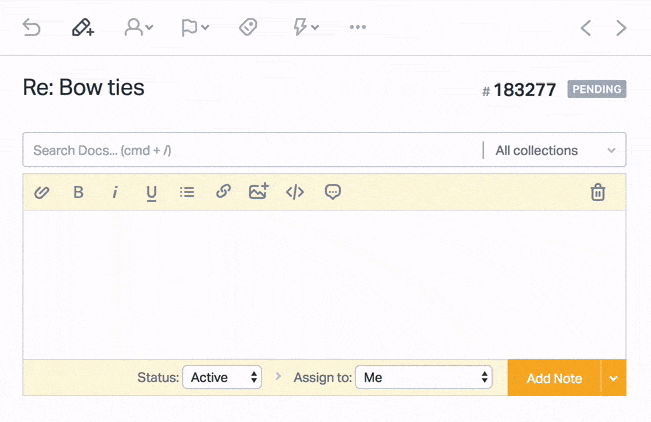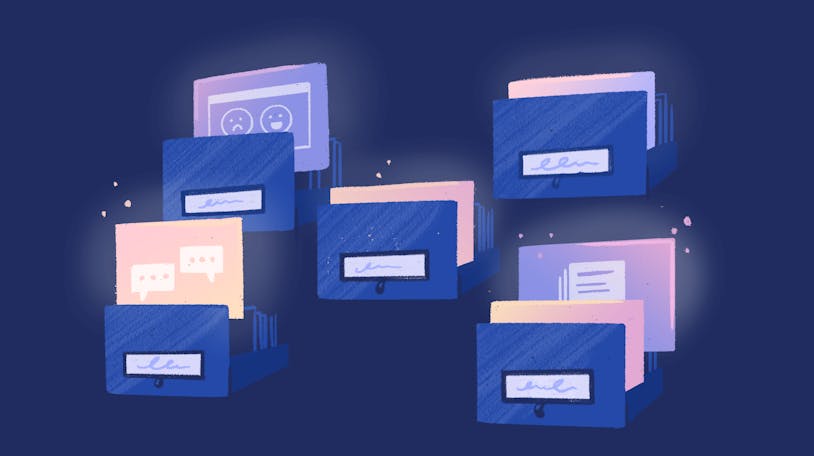How To Write a Good Internal Note


I often take notes on my phone, typically late at night or when I’ve just woken up. Upon later review, a fair percentage of those notes are incomprehensible. One customer service article idea late-night-Mathew apparently had was, “For safety, treat exhaust with catalytic converters.” What was that for? Your guess is as good as mine.
It’s very easy in Help Scout (and in most help desk tools) to attach internal notes or memos to a customer conversation, but making those notes truly useful takes a little more thought and effort.
Here’s how to get the best results from the internal notes feature in your help desk.
Try the customer support platform your team and customers will love
Teams using Help Scout are set up in minutes, twice as productive, and save up to 80% in annual support costs. Start a free trial to see what it can do for you.
Try for free
The benefits of good internal notes
Internal notes are typically used to pass information that isn’t relevant or helpful for the customer to see between internal staff. That might include additional context about the customer or the topic at hand or some instructions to follow.
Outcomes from writing better internal notes include:
Faster service — Good notes can summarize long conversations, reducing the effort of the next person to handle the conversation.
Increased consistency — When all internal staff are working from the same information, the resolution of the customer’s issue should be consistent no matter who handles it.
Reduced cherry-picking — Conversations that appear long or complex can languish in the support queue because it isn’t immediately clear how to handle them. Good notes can make a long-running conversation easier to pick up.
Easier cross-team collaboration — When a customer’s question needs help from teams outside frontline support, good notes smooth the transition and increase the chance of a speedy response.
Improved team learning — Internal notes are a really effective tool for teaching team members how to handle a given situation. If your company tries all-hands support, internal notes are a vital tool for both teaching and reviewing draft messages. At Help Scout, every new starter across the company spends time in support. Internal notes make the internal quality review process easier and the customer’s experience more consistent.
Key elements of an effective internal note
An excellent internal note isn’t too different than an excellent reply to a customer. Both should be clear, concise, accurate, and focused on the reader’s needs. An effective internal note should do some or all of these things:
Include any unique knowledge — A lot of valuable knowledge is locked up inside the heads of experienced support team members. An internal note is a great place to share that knowledge with other team members.
Set out next steps — In some cases there will be a process that needs to be followed, and a good note will include those steps.
Assign responsibility — When you need a particular person or team to take action, ensure the note makes that request clear.
Reduce time to get up to speed — Conversations can get long and complex. Don’t make your colleagues read through a 20-message thread; summarize the important information in your note. Tools like Help Scout’s AI summarize feature make this process easier by enabling you to create a bulleted summary of any conversation with just a click of a button.
Give important context — Is this a VIP customer, or is this a question related to a recent product outage? Include this context to help your colleagues answer appropriately.
Align the team on an agreed approach —A lot of customer service involves personal judgement. By setting out the approach you intend to take, you help others reply in a consistent manner.
Write for the intended audience — If your note is asking an executive to make a call on a refund, it will include a different level and type of detail than a note for your support colleague would.
Include any important dates and times — Is the customer on a deadline, or have you promised them a timeline? Repeat that information in the note so it doesn’t get missed.
Consider using workflows to add internal notes — Certain types of customer conversations can be automatically recognized by key words or incoming email address. Use workflows (or any help desk automation you have access to) to add an internal note that tells team members what needs to happen. For example, our Customers team uses workflows to automatically add notes which help the team implement Support-Driven Growth principles.
Mention the relevant people — Help Scout’s @mention feature is a fast way to bring a note to the attention of the right people, especially if they won’t necessarily own the conversation. Consider mentioning a new team member or a team lead who should be aware of a situation.

Signs of an unhelpful note
One category of unhelpful notes is the unnecessary note. If a conversation is straightforward, or will be quickly resolved, a note might not be worth adding.
Watch out for notes in which:
There is no clear audience — It should be obvious which person or group a note is intended for. You don’t want support teams puzzling over details aimed at engineering. Label your note appropriately.
The next action isn’t clear — If there is something that needs to happen, make it obvious; don’t make the reader hunt for it.
Too much detail obscures the key information — An engineer or a QA person probably doesn’t need to know the entire history in order to verify one issue. Tell them only what they need to know.
There is rude or aggressive content — One day, you’re going to make a mistake and send what you think is a private note to a customer. Keep it on-topic and on-brand, even internally.
Making a notable improvement
Whenever you next see a really helpful internal note, be sure to share it with your teammates and let them know the difference it makes. Writing a great internal note may take a little extra time up front, but that time will be outweighed by the benefits to anyone reading it in the future (yourself included!)
By acknowledging the behavior you want see, you’ll reinforce good habits and remind your colleagues why good notes matter.
The Supportive Weekly: A newsletter for people who want to deliver exceptional customer service.
